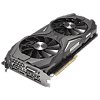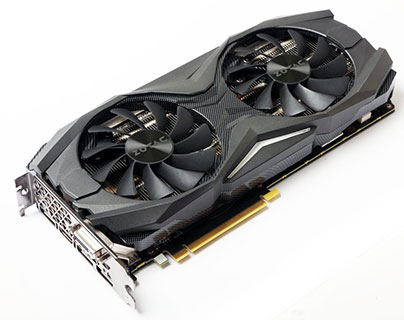 43
43
Zotac GTX 1080 AMP! Edition 8 GB Review
(43 Comments) »Introduction

NVIDIA's GeForce GTX 1080 was released earlier this summer and impressed with incredible performance and even more incredible power efficiency. The GeForce GTX 1080 is based on NVIDIA's "Pascal" architecture. This architecture sees the streaming multiprocessors (SMs), the indivisible subunits of an NVIDIA GPU, get even more dedicated components, which increases their performance. NVIDIA claims to have "meticulously" designed the GPU architecture to be as energy efficient as possible given the silicon fab node and is leveraging the 16 nm FinFET node at TSMC for "Pascal."
The GTX 1080 features more CUDA cores than its predecessor – 2560 vs. 2048. It features even more TMUs (160 vs. 128) and, at 8 GB, double the memory. Memory technology sees a major update with NVIDIA's adoption of the GDDR5X memory standard. The memory is clocked at a staggering 10 GHz effective, which gives the GPU 320 GB/s of memory bandwidth over a 256-bit wide memory interface.
To learn more about the architecture and new GeForce features, check out our launch-day review of the GeForce GTX 1080.

Today, we have the Zotac GeForce GTX 1080 AMP! Edition on our test bench, the company's second-highest clocked custom-design GTX 1080. Zotac's other models are the AMP! Extreme, which comes with a bigger cooler and higher clocks, Arctic Storm, which is designed for watercooling, and the Founders Edition reference design.
Zotac uses a dual-slot, dual fan cooler on the GTX 1080 AMP! Edition, which is almost completely made out of metal, giving the card a high-quality look and feel. Priced at $670, which is around $30 cheaper than the Founders Edition, it is one of the cheaper GTX 1080s out there.
| Radeon R9 Fury X | GeForce GTX 980 Ti | GeForce GTX Titan X | GeForce GTX 1070 | GeForce GTX 1080 | ZOTAC GTX 1080 Amp! | |
|---|---|---|---|---|---|---|
| Shader Units | 4096 | 2816 | 3072 | 1920 | 2560 | 2560 |
| ROPs | 64 | 96 | 96 | 64 | 64 | 64 |
| Graphics Processor | Fiji | GM200 | GM200 | GP104 | GP104 | GP104 |
| Transistors | 8900M | 8000M | 8000M | 7200M | 7200M | 7200M |
| Memory Size | 4 GB | 6 GB | 12 GB | 8 GB | 8 GB | 8 GB |
| Memory Bus Width | 4096 bit | 384 bit | 384 bit | 256 bit | 256 bit | 256 bit |
| Core Clock | 1050 MHz | 1000 MHz+ | 1000 MHz+ | 1506 MHz+ | 1607 MHz+ | 1683 MHz+ |
| Memory Clock | 500 MHz | 1750 MHz | 1750 MHz | 2002 MHz | 1251 MHz | 1251 MHz |
| Price | $600 | $440 | $1150 | $380 / $450 | $600 / $700 | $670 |
Packaging
You will receive:
- Graphics card
- Driver CD + documentation
- 2x PCIe power cable
The Card
Zotac is using a large dual fan cooler on their new design, the large dark grey parts made of metal, which definitely adds to the quality. The checkerboard textured pieces are out of well-made plastic. On the back, you find a sturdy metal backplate. Dimensions of the card are 29 cm x 14 cm.
Installation requires two slots in your system.
Display connectivity options include a DVI port, an HDMI port, and three DisplayPorts. Unlike previous NVIDIA cards, the DVI port no longer includes the analog signal, so you'll have to use an active adapter. NVIDIA also updated DisplayPort to be 1.2 certified and 1.3/1.4 ready, which enables support for 4K @ 120 Hz and 5K @ 60 Hz, or 8K @ 60 Hz with two cables.
The GPU also comes with an HDMI sound device. It is HDMI 2.0b compatible, which supports HD audio and Blu-ray 3D movies. The GPU video encoding unit has been updated to support HEVC at 10-bit and 12-bit.
NVIDIA made some changes to SLI. Two-way SLI is now the only officially supported configuration for gaming. Three-way or Quad SLI can no longer be enabled in games; however, both do work in a few benchmarks. Also, for 4K at 60 Hz and above, NVIDIA recommends a new high-bandwidth SLI bridge called "SLI HB," which occupies both SLI fingers. The old bridges will work fine at lower resolutions.
Pictured above are the front and back, showing the disassembled board. High-res versions are also available (front, back).
Our Patreon Silver Supporters can read articles in single-page format.
Jul 29th, 2025 15:38 CDT
change timezone
Latest GPU Drivers
New Forum Posts
- Looking To Make List Of Keyboard Manufacturers (21)
- 3D Printer Club (572)
- RX6800XT Gigabyte Gaming OC not giving image while being on "OC" switch and even sometimes while being on "silent" switch. (2)
- AI Job Losses: let's count the losses up, total losses to AI so far 94,000 and counting (79)
- Choosing the right motherboard (14)
- What antivirus do you use? (46)
- What's your latest tech purchase? (24391)
- Upgrade from old x58 system (56)
- Have you got pie today? (16814)
- What are you playing? (24024)
Popular Reviews
- Herman Miller Logitech G Embody Review - No Pain, No Gain
- Lian Li O11 Dynamic Mini V2 Review
- Lenovo Legion 5i (15IRX10) Review - Feature-Rich and Wallet Friendly
- Upcoming Hardware Launches 2025 (Updated May 2025)
- Noctua NF-A12x25 G2 PWM Fan Review
- Sapphire Radeon RX 9060 XT Pulse OC 16 GB Review - An Excellent Choice
- MSI Claw 8 AI+ A2VM Review
- AMD Ryzen 7 9800X3D Review - The Best Gaming Processor
- AQIRYS Sirius Pro Review
- VAXEE XE V2 Wireless Review
TPU on YouTube
Controversial News Posts
- AMD's Upcoming UDNA / RDNA 5 GPU Could Feature 96 CUs and 384-bit Memory Bus (134)
- AMD Radeon RX 9070 XT Gains 9% Performance at 1440p with Latest Driver, Beats RTX 5070 Ti (131)
- NVIDIA GeForce RTX 5080 SUPER Could Feature 24 GB Memory, Increased Power Limits (115)
- Intel "Nova Lake-S" Core Ultra 3, Ultra 5, Ultra 7, and Ultra 9 Core Configurations Surface (110)
- DDR6 Memory Arrives in 2027 with 8,800-17,600 MT/s Speeds (99)
- AMD Sampling Next-Gen Ryzen Desktop "Medusa Ridge," Sees Incremental IPC Upgrade, New cIOD (97)
- Intel CEO Confirms SMT To Return to Future CPUs (95)
- NVIDIA Becomes First Company Ever to Hit $4 Trillion Market-Cap (94)









